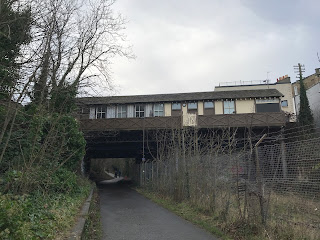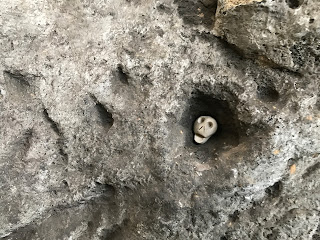I haven’t walked down the path to Oxroad Bay for a few years. Last time I walked along it, there had been a landslide and part of the path had fallen away. This led to a slightly dangerous walk along a ledge with a sheer drop of twenty to thirty feet to the rocks below.
My walk along the path began as an easy
wander down the side of a field that lies on the road to Seacliff Beach. The path runs by an old, stone wall and
Tantallon Castle dominates the view on the way along. I then made my way down through a gap at the
end of the field and on to the steep path that leads down to the bay.
As I made my way down, I could see that
there had been numerous landslides since the last time I had ventured that way
and the path was now a muddy slide that in places ran to the cliff edge. It didn’t look to safe, but hey, everyone
needs a bit of danger in their life to really appreciate being alive. So, I
made my way down, leaning to the side away from the cliff edge just in case I
slipped and fell. Better splattered with
mud that splattered on the rocks.
It wasn’t the most comfortable journey down, but I made it and then realised I’d have to go back up that way again. That spoilt the joy of being in the seclusion of the bay a bit. And it was secluded. The tide was quite high, so the bay was completely cut off with cliffs towering above on all sides.
The cliffs around Oxroad Bay are mainly made up of volcanic rock, however, there is a band containing cementstones in which lots of fossils have been found. These have mainly been fragments of fish, though various species of pteridosperms and lycopods have also been discovered in them.
Not being much of a fossil collector, I walked around the bay in the morning sunshine and watched the sea birds wading in the few feet of mud exposed by the sea. They called out in alarm on seeing me wandering along the beach, a big, clumsy human in a bright waterproof jacket with a bunnet on his head.
I found some rocks to sit on and closed
my eyes. The winter sun warmed my face and
the soothing lap of the waves made me feel at one with everything around me. Then I remembered I had to get back up the
path again. Reverie ruined, I got up and
made my way back round to the path and began my ascent. On looking at it again I realised there were
only really two bits that were bad. In
total maybe ten feet of the path and for some reason I decided that running up
would be easiest, as being light of foot and fast would present the least
danger. It worked, and soon I was back
up on the main path.
As I made my way back, I stopped by the
old wall running along the path and left a Skulferatu in a gap by a love heart
shaped stone.
The coordinates for the location of the
Skulferatu are –
Latitude 56.052649
Longitude -2.6472330
I used the following sources for
information on the fossils at Oxroad Bay –
UK Fossils Network
Article and photographs are copyright of © Kevin Nosferatu, unless otherwise specified.













































